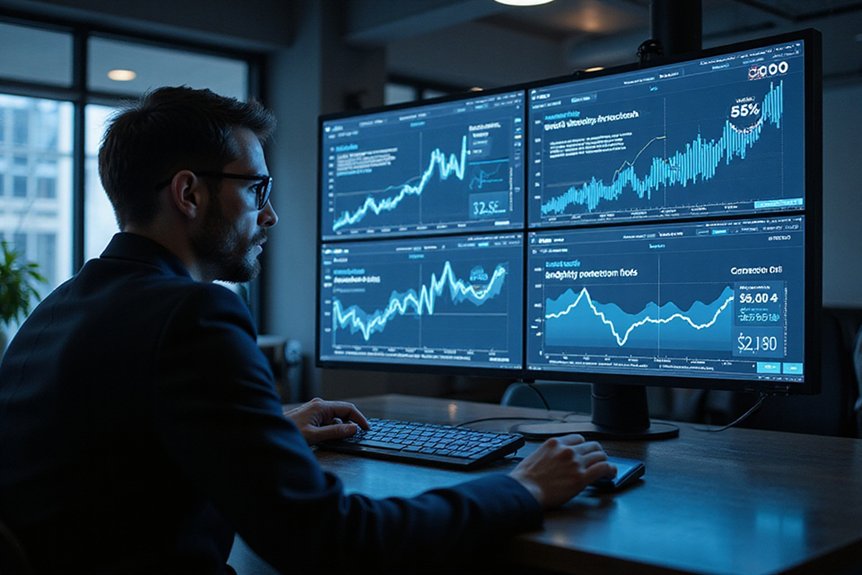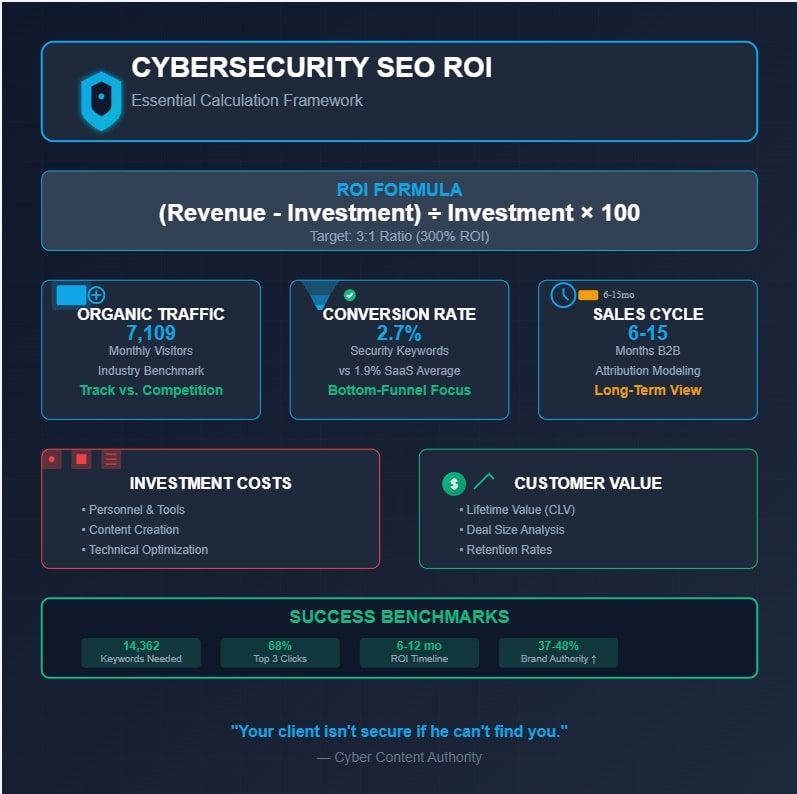Cybersecurity software companies, operating in a highly competitive market with sophisticated B2B buyers, require precise calculations of ROI for cybersecurity software SEO investments to justify continued allocation of resources. When calculating SEO ROI for these specialized firms, marketing strategists must account for extended sales cycles, complex attribution models, and the incremental authority gained through organic visibility in technical security forums. The methodical quantification of organic traffic value, when mapped against industry-specific conversion rates and customer lifetime value metrics, reveals whether SEO expenditures are generating sustainable returns—a critical determination that influences broader digital marketing strategies.
Key Takeaways
- Calculate conversion value by multiplying security-focused keyword conversion rates (2.7%) with average deal sizes.
- Determine investment costs by totaling personnel, technology, and content creation expenses for SEO campaigns.
- Implement attribution models that account for lengthy B2B cybersecurity sales cycles, typically 6-15 months.
- Track organic traffic metrics against industry benchmarks (7,109 monthly visitors) to measure competitive positioning.
- Aim for a 3:1 or higher ratio between customer lifetime value and acquisition costs for profitable SEO ROI.
Understanding SEO Metrics Critical for Cybersecurity Software

Steering through the complex intersection of search engine optimization and cybersecurity requires an extensive understanding of metrics that specifically impact software companies operating in the security sector.
Domain authority, which differentiates industry leaders from competitors, represents a foundational metric that, when tracked systematically against industry benchmarks, reveals strategic positioning opportunities. Long-tail keywords can drive more targeted traffic, making it essential for cybersecurity firms to integrate them into their SEO strategies.
Effective SEO strategies for cybersecurity entities must prioritize both keyword optimization for technical terms like “threat detection” and engagement metrics, which signal to search algorithms the relevance and utility of content. Research shows cybersecurity startups need approximately 14,362 ranking keywords to achieve average industry visibility.
SEO excellence in cybersecurity demands tactical keyword implementation while cultivating meaningful user engagement metrics.
HTTPS implementation, beyond its security implications, serves as a ranking factor that simultaneously enhances user trust and search visibility. Mobile optimization is critical for retaining visitors and can significantly impact the effectiveness of cybersecurity firms’ online presence.
Essential Components of the Formula for ROI for Cybersecurity Software SEO
While examining the financial impact of search visibility strategies, cybersecurity software companies must recognize that calculating SEO ROI requires a methodical approach built upon several interconnected components, each contributing to an extensive evaluation framework that quantifies returns against expenditures. Implementing a standardized ROI formula will help security solution providers accurately measure the profitability generated from their SEO investments. Additionally, 68% of online experiences begin with a search engine, highlighting the importance of effective SEO in driving traffic.
| Component | Strategic Application |
|---|---|
| Conversion Value | Assigns monetary worth to lead acquisitions, sales conversions, or subscription sign-ups |
| Investment Costs | Encompasses personnel, technology, content creation, and consulting expenditures |
| Attribution Models | Determines how conversions are credited across multi-touch customer journeys |
| Timeframe Analysis | Establishes evaluation periods for accurate ROI Calculation benchmarking |
| Competitive Metrics | Positions performance against industry standards to contextualize Investment Metrics |
Tracking Organic Traffic Value in the Cyber Defense Market
The quantification of organic traffic value represents a foundational pillar for cybersecurity software companies seeking to validate their SEO investments, particularly as competition intensifies within the rapidly evolving cyber defense marketplace.
Through sophisticated organic traffic tracking methodologies, security vendors can establish correlations between digital visibility and revenue generation, thereby justifying continued investment in search acquisition strategies.
- Measure baseline traffic volume against industry benchmarks, noting that related sectors average 7,109 monthly visitors.
- Calculate effective conversion rates across key cybersecurity metrics, including leads-to-sales ratios.
- Determine traffic monetary value through established CAC reduction formulas.
- Implement progressive monitoring of first-page keyword rankings to quantify competitive positioning.
Securing positions among the top 3 results on Google significantly increases visibility potential, as these results receive over 68% of all clicks in search queries related to cybersecurity solutions. Over 7 billion searches conducted on Google daily highlight the vast potential for attracting organic traffic.
Converting Security-Focused Keywords Into Revenue Estimates

Converting security-focused keywords into revenue estimations requires a robust methodology that quantifies the financial value of each lead generated through organic search. When calculated effectively, this establishes a clear connection between SEO investments and return on investment.
Security software companies that understand search intent variations, particularly bottom-of-funnel keywords like “managed SIEM service pricing,” typically experience conversion rates 3-5 times higher than top-of-funnel terms. This understanding enables them to more accurately predict revenue potential from their SEO efforts. Developing a successful strategy involves data-driven decisions that leverage metrics from professional research tools to continuously refine keyword performance for optimal results.
Security Lead Worth Calculation
Accurately quantifying the monetary value of security-focused leads, generated through targeted SEO campaigns, represents a critical challenge for cybersecurity software companies seeking to justify their digital marketing investments.
Effective security lead evaluation requires systematic conversion tracking methodology, which, when implemented properly, transforms abstract keyword performance into concrete revenue projections that can withstand executive scrutiny.
Four essential components for calculating security lead worth:
- Determine Customer Lifetime Value (CLV) by analyzing historical revenue patterns
- Multiply lead-to-sale conversion rates by average deal size
- Factor in risk assessment metrics, including Exposure Factor
- Apply channel-specific attribution models to isolate SEO contribution
Understanding that not all leads hold equal value is fundamental when calculating the worth of security-focused prospects converting through search engine optimization efforts.
Impact of Search Intent
Why do some security-focused keywords generate substantial revenue while others fail to convert despite high search volume? The critical difference lies in search intent alignment, which determines whether traffic converts to qualified leads or merely increases bounce rates without generating revenue.
When cybersecurity companies analyze user behavior patterns, particularly for high-value keywords like “enterprise antivirus solutions,” they can develop content that precisely matches searcher intent at each funnel stage.
This strategic keyword alignment, which requires thorough audience analysis and competitor research, transforms basic traffic metrics into predictable revenue streams by attracting users with specific purchasing intentions rather than merely informational queries. Incorporating high-value keywords throughout digital platforms significantly enhances organic reach and targeting capabilities for cybersecurity companies seeking qualified prospects.
Traffic-To-Sales Conversion Metrics
The transformation of organic traffic into quantifiable revenue represents the cornerstone of effective SEO measurement for cybersecurity software companies, requiring sophisticated tracking mechanisms that correlate keyword performance with actual sales outcomes.
Traffic analysis reveals that security-focused keywords, when properly targeted, can yield conversion rates approaching 2.7%, markedly outperforming general industry averages of 1.9% for SaaS companies.
Companies with high-value cybersecurity solutions should note that their customer lifetime value might warrant more aggressive acquisition strategies, as businesses with CLV between $10,000 and $100,000 typically achieve conversion rates of 2.1%.
- Implement page-specific conversion tracking to identify high-performing security content
- Calculate Average Order Value (AOV) × conversion rate to estimate revenue potential
- Segment traffic by keyword intent categories, measuring conversion trends across each
- Establish industry-specific benchmarks, considering that cybersecurity solutions typically demonstrate higher CPA but greater lifetime value.
Measuring Customer Acquisition Costs Through Organic Search
Many cybersecurity software companies struggle to precisely quantify the return on investment from their SEO efforts, particularly when calculating customer acquisition costs through organic search channels.
To accurately determine CAC, organizations must aggregate all expenses related to SEO implementation—including personnel salaries, tool subscriptions, content creation, and technical optimization—then divide by the number of customers acquired through these channels. Cybersecurity firms should aim for an ideal ratio of 3:1 or higher between customer lifetime value and acquisition costs to ensure profitability.
In addition, when evaluating long-term effectiveness, companies must consider how customer retention and lead nurturing impact the overall value proposition, as high-performing organic content frequently attracts prospects with superior alignment to product offerings.
Long-Term Value of SEO for Cybersecurity Brand Authority
Establishing long-term brand authority represents a significant, often overlooked component when calculating SEO ROI for cybersecurity software companies.
Many cybersecurity firms neglect brand authority’s critical impact on their SEO return calculations.
While immediate metrics focus on rankings and traffic, a thorough SEO strategy, which emphasizes consistent messaging across digital platforms and publishing of authoritative cybersecurity content, ultimately transforms into measurable brand equity, thereby enhancing conversion rates over extended periods.
- Development of topical authority through strategic content creation increases brand visibility by 37-48% over a 24-month implementation period.
- Backlink acquisition from industry-recognized sources elevates domain authority metrics, as high-quality backlinks are among Google’s most important ranking factors.
- Educational content performance correlates with 22% higher client retention rates.
- Consistent keyword optimization enhances brand association with critical security solutions.
- The implementation of technical SEO practices significantly improves a cybersecurity company’s credibility and trust, which are essential factors when clients evaluate security solution providers.
Implementing ROI Tracking Systems for Ongoing SEO Campaigns

Implementing effective ROI tracking systems constitutes a foundational element for cybersecurity software companies seeking to quantify SEO performance over extended campaign periods, particularly as organic search initiatives require significant resource allocation before yielding measurable results.
For peak performance analysis, these organizations should:
- Integrate Google Analytics with CRM platforms to track organic lead progression through sales funnels.
- Establish conversion goals specific to cybersecurity software acquisition processes.
- Apply attribution modeling that accounts for lengthy B2B decision cycles.
Companies should anticipate a break-even time of 6-15 months when evaluating campaign effectiveness in the cybersecurity sector.
Regular campaign adjustments, based on thorough data integration from multiple analytics sources, enable cybersecurity firms to optimize resource allocation while demonstrating tangible ROI to stakeholders through systematic measurement frameworks.
Calculate Your ROI For Cybersecurity Software SEO
Calculating ROI for cybersecurity software SEO, while inherently complex due to extended sales cycles and multiple touchpoints, remains essential for strategic resource allocation and competitive advantage. Forward-thinking security firms must, as a result, implement thorough attribution models that account for both quantitative metrics and qualitative factors, such as brand authority and thought leadership positioning, which, despite being difficult to quantify, greatly impact long-term market position and customer acquisition efficiency.

Frequently Asked Questions
How Do Privacy Regulations Impact SEO ROI for Cybersecurity Companies?
Privacy regulations enhance ROI for cybersecurity software SEO by converting compliance into competitive advantages. Staying current with regulation updates demonstrates expertise and cultivates trust, driving organic visibility and qualified lead generation.
Should Cybersecurity Startups Prioritize SEO Over Other Marketing Channels?
Cybersecurity startups should balance SEO with other channels. SEO provides sustainable traffic generation through targeted content strategy, but may require complementing with faster-acting tactics for immediate visibility while building organic presence.
How Does Competitive Density Affect SEO ROI in Cybersecurity?
Competitive density amplifies keyword rivalry, requiring higher investments for visibility. Market saturation in cybersecurity necessitates sophisticated differentiation strategies, potentially decreasing SEO ROI unless companies leverage niche specialization and technical innovation.
Can Enterprise and SMB Cybersecurity Solutions Use Identical SEO Metrics?
Enterprise metrics and SMB metrics cannot be identical due to differences in scale, conversion complexity, attribution models, and reporting infrastructure. While fundamental KPIs overlap, enterprises require more sophisticated measurement frameworks for accurate performance assessment.
How Quickly Should Cybersecurity Companies Expect Positive SEO ROI?
Cybersecurity companies typically see positive SEO ROI within 6-12 months. Industry SEO timelines vary based on competition intensity, content quality, and technical optimization. Forward-thinking firms should benchmark against marketing benchmarks while remaining patient.

